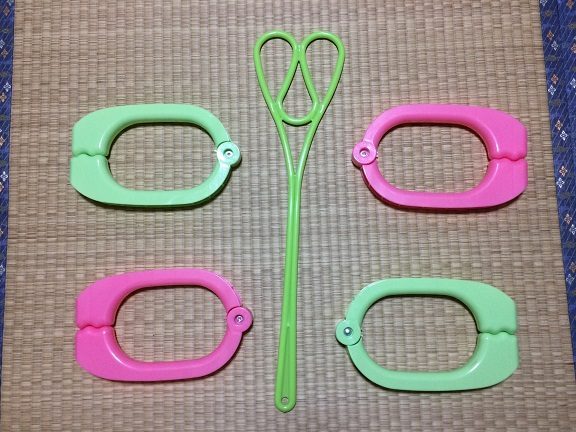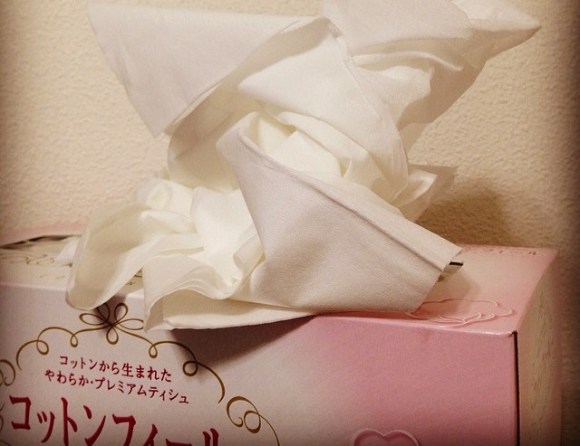
There’s something in this person’s kitchen and I don’t know what it is.
One of the best kinds of culture shock has to be when you’re alone and suddenly encounter something, either in a store or someone’s home, and you have no idea what it is. It typically leads to a few moments of silent consideration, followed by your brain struggling to come up with some sort of use for it, and then inevitably being giggled at by your foreign friends when they explain to you what it’s actually used for.
And of course Japan has plenty of strange things too. The average home has several items that might be baffling at first glance to foreign guests, but make complete sense once you dig a little deeper.
That’s why today we’re counting down the top five strangest Japanese home goods. Now when you encounter these items, you won’t have to look like a deer in headlights, you can handle them like a native pro.
So let’s get to it! Starting off with…
Honorable Mention: Tissues
The first item on our list isn’t so much something that will make you stop in your tracks when you see it, but rather something that might make you stop when you see what it’s being used for.
In Japan, tissues are commonly used for everything. They’re used to clean up messes in the kitchen (often instead of paper towels), and they’re also used when eating (often instead of napkins). In fact, ironically enough, one of their less-common uses is blowing your nose.
Using tissues in such a variety of situations may not seem all that strange to some, hence it only being an honorable mention, but I still get a weird feeling that I just can’t shake every time I see tissues used to clean up a spill instead of paper towels. Even to this day, it still feels like a novelty to have a box of tissues at the table when I’m eating. Although I do have to admit, it does make it a lot easier when I let my foreignness erupt out of my nose with a sneeze in the middle of dinner and the tissues are right there.
#5. Bathtub cover
https://twitter.com/cute_aaa_/status/833007712694722560So you’re at your Japanese friend’s house to spend a few days and you’re anxious to take a shower after spending most of your day crossing the ocean in a stuffy airplane. You walk into the bathroom, strip down, get ready to plop in the tub… until you see that there’s a cover over it.
▼ Oh, well, I guess this is awkward for both of us now.
風呂のフタは暖かいからお尻が気持ちいいのかね(*´ω`*) pic.twitter.com/DI2cKfX2vU
— サバイバー 01 (@IHsacp5fd7j7Y3n) December 16, 2016
In Japan it’s fairly common for families to use the same bathwater to conserve water. That may sound kind of gross at first, but bathrooms in japan typically separate the bathtub from the shower (which we’ll see in more detail later), and the family members only go into the warm bathwater after having washed themselves off in the shower first, so the bathwater stays clean.
In order to keep the water warm, they sometimes make use of a bathtub cover (called a furo futa in Japanese). They’re typically made out of plastic and look like a series of planks that can be folded together.
▼ If you’ve ever seen a tablet cover like this,
it’s basically the same thing, but for the bathtub.
iPadに風呂のフタ付けた pic.twitter.com/U4mHS1cS
— syu (@trinity33r) March 21, 2012
The cover helps keep the heat in, keeping the water warmer longer. It also has a nice aesthetic to it, covering up what is ostensibly a giant hole in the bathroom.
▼ It also prevents certain furry members of the
family from getting their hair in the tub too.
#4. Net strainers
水切りネットを買ったのですが、さすがにこれ(写真の下側)は不良品じゃないでしょうか。 pic.twitter.com/fml7G3m2qY
— 飛天無縫@FE風花雪月二次小説 (@hi_te_n_mu_ho_u) November 24, 2016
So you just spent the night at your Japanese friend’s house and he has to rush out to work in the morning. But before he does, he asks if you can do one favor for him: replace the sink’s net strainer. You say sure, he smiles and leaves, and then you walk over to sink… and realize you have no idea what he was talking about.
▼ But never fear! This is what he means.
お徳用50枚入り!ゴミポン ナイスフィット 50枚入り【三角コーナーネット】【水切りネット】【排水口ネット】【ストッキングタイプ】【10P03Sep16】 https://t.co/7MbdvfQLfu pic.twitter.com/VbG3x91Cna
— 人気商品ナンバーワン!! (@ninki18) September 15, 2016
Japanese sinks are a little different than you may be used to. Instead of using a garbage disposal or just nonchalantly shoving chunks of garbage down the sink while screaming “FREEDOM!” like we might do in the U.S., Japanese people usually have a metal strainer inside the sink, which is what’s in the tweet above.
The metal strainer catches garbage so it doesn’t clog up the pipes, but it can get kind of gross and hard to clean if you’re not careful, so to make it easier many people use net strainers (called mizukiri netto in Japanese). The nets wrap around the inside of the metal strainer so that when it starts to fill up, stink, or comes time to clean, all you have to do is throw away the net, put in a new one, and you’re golden.
▼ Some homes also opt for a triangle-strainer that sits in the corner of the
sink too, which you’re supposed to put food waste into and then throw out.
Sink net-strainers aren’t uniquely Japanese, but they’re very widespread here, and I’d never personally encountered them before first coming to Japan.
So now if you’re in a Japanese kitchen, and you see someone pick up a giant net of garbage from their sink, you don’t have to worry – they didn’t just stick their hand down the drain and yank out a clog – they’re just changing their net strainer.
#3. Bathroom slippers
12月のイベントのプレゼント当たった人
— よす (@cafe_Route66) January 18, 2017
その一人、Routeのスリッパ
トイレのスリッパになってる… pic.twitter.com/cUaDq5NBIO
Nature calls, and now it’s time to use your Japanese friend’s bathroom. You open the door, and even though the toilet itself looks a little weird, so far so good.
Until you see what’s on the floor:
▼ They may not be labeled this clearly, but there are almost
definitely slippers there waiting in the bathroom.
トイレのスリッパ履いてそのまま戻ってきた人がいるww pic.twitter.com/unup9P1KHj
— そーしん (@soshin7111) January 6, 2017
Pretty much anyone who’s been to Japan before knows that shoes coming off before going inside someone’s house is a necessity. In the U.S. and other parts of the world shoes staying on is the norm, but for the average Japanese household, walking around indoors with shoes on is almost as bad as walking around caked in mud.
But then, when you go into the bathroom, shoes come back on in the form of slippers. Since even the cleanest bathroom is regarded as “dirtier” than the rest of the house, Japanese people don’t want to walk around the living room, bedroom, and kitchen with anything they picked up from the bathroom, so it makes sense to have a pair of “bathroom-only slippers” from that point of view.
▼ Still, it can be a bit strange to see slippers advertised
as part of a “bathroom set” for an outsider.
【Disney/ディズニー】プリンセス 美女と野獣 ベル トイレ蓋カバー&トイレマット&スリッパ&ペーパーホルダー 豪華4点セット!☆★送料無料(北海道、沖縄、...https://t.co/8xXLYpvhhv pic.twitter.com/QrAPCFTHhc
— 占い師が作るあなただけのお守りの店 (@FkaPg) January 8, 2017
▼ Slippers can also be found in some public restrooms as this sign reads:
“Do not wear the bathroom slippers outside of the bathroom.”
トイレのスリッパーは表にはき、出ないでください。 pic.twitter.com/AQbMpjOJqP
— なむ (@num_heavy) December 3, 2016
Personally, I’ve never gotten used to bathroom slippers. They still seem strange to me and I tend to just push them aside with my bare/socked feet while in the bathroom… just please don’t tell any of my Japanese friends that.
#2. Shower stools
気になってた風呂椅子表面のざらざら薄茶色の石鹸かすや水垢、クエン酸でひたすら磨いてつるつる真っ白にした。気がついたら一時間磨いてた。 pic.twitter.com/LZF6LE5tBH
— カリノ トウコ (@linoleums) February 5, 2017
After not bathing yesterday at your Japanese friend’s house, your stink levels have peaked, and now you need to take a shower. So you finally brave the bathroom once again, strip down, turn on the shower head, and start to think you may get through this okay, until you see something you don’t recognize.
▼ It’s small, cute, and weird.
Also there’s a plastic stool you don’t recognize either.
風呂椅子占領 pic.twitter.com/Ga1fRxLlBi
— まつお (@torara226) February 4, 2017
The plastic stool (called a furo isu – “bath chair” – in Japanese) is what you’re supposed to sit on when you’re taking a shower. Most Japanese shower heads are handheld, meaning you can pick them up and spray any part of your body that you want.
While you’re perfectly able to just latch the shower head onto the wall and take a shower standing up, many Japanese people instead opt to sit on a stool and shower. Some find it easier to wash themselves this way, and they often turn the water off when they don’t immediately need it (such as when they’re putting soap on themselves or shampoo in their hair), saving water in the process.
And the #1 strangest Japanese home good is…
.
.
.
.
.
.
.
.
.
.
1. Futon beaters and giant clips

It’s your last day at your Japanese friend’s house. He asks if you can help him clean up your sleeping area before you go, and you say sure, but then he hands you a bunch of giant clips and a beating stick. You tell him, “I mean, I like you too, but I didn’t know you were into that!”
But no, your friend isn’t into hardcore BDSM, they just want to use the clips and beater to clean your futon!
What do any of these things have to do with cleaning a futon? Easy. You’re supposed to drape the futon over your apartment’s balcony, use the clips to hold it tightly in place, and then whack it repeatedly with the stick to get all the dust and mold out.
▼ “Hey, what I said about liking you… I meant as a friend.
A futon-beating friend. That’s all.”
Since sleeping on the floor isn’t too popular outside of Japan (even though it’s awesome!), it’s no surprise that the tools used to clean futons would be unrecognizable to outsiders.
You can pick up pretty much any of the items on this list at any 100 yen store in Japan, so the next time you’re there be sure to grab some bathroom slippers, shower stools, and futon clips/beaters to really confuse your friends when they come over.
▼ “Dude, why do you have a Satan-summoning-stick in your house?”
“Sigh….“
So there you have it, the top five strangest Japanese home goods. Have you ever encountered something in another country that you had no idea what it was used for? Let us know in the comments, but if there’s one thing that’s universally understood, it’s cute animals, so be sure to check out the top five most famous pet dogs in Japan to see the powerful pups Japan has to offer.
Top image: PAKUTASO (edited by RocketNews24)
W.T.F. Japan will be back next Thursday. In the meantime, give me a follow on Twitter and let me know if there’s any topics you’d like to see covered. See you next week!


 Do you really need to wear toilet slippers when using the bathroom at home? Japan’s netizens vote
Do you really need to wear toilet slippers when using the bathroom at home? Japan’s netizens vote Tokyo condo frees up space by putting a shower in the kitchen
Tokyo condo frees up space by putting a shower in the kitchen Japan’s awesome, eco-friendly, old-school water heaters (and how to use them)
Japan’s awesome, eco-friendly, old-school water heaters (and how to use them) 4 freezer tips for beating the summer stink from everything from sweaty shoes to rotting garbage
4 freezer tips for beating the summer stink from everything from sweaty shoes to rotting garbage Over half of Japanese adults do this in the shower – How about you?
Over half of Japanese adults do this in the shower – How about you? McDonald’s new Happy Meals offer up cute and practical Sanrio lifestyle goods
McDonald’s new Happy Meals offer up cute and practical Sanrio lifestyle goods All-you-can-drink Starbucks and amazing views part of Tokyo’s new 170 meter-high sky lounge
All-you-can-drink Starbucks and amazing views part of Tokyo’s new 170 meter-high sky lounge Studio Ghibli glasses cases let anime characters keep an eye on your spectacles
Studio Ghibli glasses cases let anime characters keep an eye on your spectacles Beautiful Sailor Moon manhole cover coasters being given out for free by Tokyo tourist center
Beautiful Sailor Moon manhole cover coasters being given out for free by Tokyo tourist center Starbucks reopens at Shibuya Scramble Crossing with new look and design concept
Starbucks reopens at Shibuya Scramble Crossing with new look and design concept Kyoto’s 100 Demons yokai monster parade returns!
Kyoto’s 100 Demons yokai monster parade returns! More foreign tourists than ever before in history visited Japan last month
More foreign tourists than ever before in history visited Japan last month Super Nintendo World expansion gets delayed for several months at Universal Studios Japan
Super Nintendo World expansion gets delayed for several months at Universal Studios Japan “Half-naked men only in loincloths” drum battle returns to Hida festival for first time in five years
“Half-naked men only in loincloths” drum battle returns to Hida festival for first time in five years Is the new Shinkansen Train Desk ticket worth it?
Is the new Shinkansen Train Desk ticket worth it? Disney princesses get official manga makeovers for Manga Princess Cafe opening in Tokyo
Disney princesses get official manga makeovers for Manga Princess Cafe opening in Tokyo Beautiful new Final Fantasy T-shirt collection on the way from Uniqlo【Photos】
Beautiful new Final Fantasy T-shirt collection on the way from Uniqlo【Photos】 Foreign English teachers in Japan pick their favorite Japanese-language phrases【Survey】
Foreign English teachers in Japan pick their favorite Japanese-language phrases【Survey】 Japanese convenience store packs a whole bento into an onigiri rice ball
Japanese convenience store packs a whole bento into an onigiri rice ball We try out “Chan Ramen”, an underground type of ramen popular in the ramen community
We try out “Chan Ramen”, an underground type of ramen popular in the ramen community Studio Ghibli releases Kiki’s Delivery Service chocolate cake pouches in Japan
Studio Ghibli releases Kiki’s Delivery Service chocolate cake pouches in Japan Japan’s bone-breaking and record-breaking roller coaster is permanently shutting down
Japan’s bone-breaking and record-breaking roller coaster is permanently shutting down New definition of “Japanese whiskey” goes into effect to prevent fakes from fooling overseas buyers
New definition of “Japanese whiskey” goes into effect to prevent fakes from fooling overseas buyers Our Japanese reporter visits Costco in the U.S., finds super American and very Japanese things
Our Japanese reporter visits Costco in the U.S., finds super American and very Japanese things Studio Ghibli unveils Mother’s Day gift set that captures the love in My Neighbour Totoro
Studio Ghibli unveils Mother’s Day gift set that captures the love in My Neighbour Totoro Foreign passenger shoves conductor on one of the last full runs for Japan’s Thunderbird train
Foreign passenger shoves conductor on one of the last full runs for Japan’s Thunderbird train Domino’s Japan now sells…pizza ears?
Domino’s Japan now sells…pizza ears? New Japanese KitKat flavour stars Sanrio characters, including Hello Kitty
New Japanese KitKat flavour stars Sanrio characters, including Hello Kitty Kyoto creates new for-tourist buses to address overtourism with higher prices, faster rides
Kyoto creates new for-tourist buses to address overtourism with higher prices, faster rides Sales of Japan’s most convenient train ticket/shopping payment cards suspended indefinitely
Sales of Japan’s most convenient train ticket/shopping payment cards suspended indefinitely Sold-out Studio Ghibli desktop humidifiers are back so Totoro can help you through the dry season
Sold-out Studio Ghibli desktop humidifiers are back so Totoro can help you through the dry season Japanese government to make first change to romanization spelling rules since the 1950s
Japanese government to make first change to romanization spelling rules since the 1950s Ghibli founders Toshio Suzuki and Hayao Miyazaki contribute to Japanese whisky Totoro label design
Ghibli founders Toshio Suzuki and Hayao Miyazaki contribute to Japanese whisky Totoro label design Doraemon found buried at sea as scene from 1993 anime becomes real life【Photos】
Doraemon found buried at sea as scene from 1993 anime becomes real life【Photos】 Tokyo’s most famous Starbucks is closed
Tokyo’s most famous Starbucks is closed One Piece characters’ nationalities revealed, but fans have mixed opinions
One Piece characters’ nationalities revealed, but fans have mixed opinions We asked a Uniqlo employee what four things we should buy and their suggestions didn’t disappoint
We asked a Uniqlo employee what four things we should buy and their suggestions didn’t disappoint Princesses, fruits, and blacksmiths: Study reveals the 30 most unusual family names in Japan
Princesses, fruits, and blacksmiths: Study reveals the 30 most unusual family names in Japan Rub-a-dub-dub and relax in a tub: Survey reveals wintertime bathing habits across Japan
Rub-a-dub-dub and relax in a tub: Survey reveals wintertime bathing habits across Japan Save time AND water by turning your shower into a bath with this nifty Japanese gadget
Save time AND water by turning your shower into a bath with this nifty Japanese gadget Japanese homebuyer finds a disturbingly weird problem with his new bathroom
Japanese homebuyer finds a disturbingly weird problem with his new bathroom How to escape when you’re trapped in a bathroom with a broken door【Video】
How to escape when you’re trapped in a bathroom with a broken door【Video】 Why your cat hates baths, but is fascinated by the bathtub
Why your cat hates baths, but is fascinated by the bathtub Can the lowest-rated portable bathtub on Amazon Japan make our office a relaxing bathhouse?【Pics】
Can the lowest-rated portable bathtub on Amazon Japan make our office a relaxing bathhouse?【Pics】 Adorable toddler is looking for prince charming with her unique “glass slippers”
Adorable toddler is looking for prince charming with her unique “glass slippers” How to have a Japanese rotenburo bath experience without leaving your home【Photos】
How to have a Japanese rotenburo bath experience without leaving your home【Photos】 Bread lovers rejoice! Toasty bread backpacks, cushions, and footwear look good enough to eat
Bread lovers rejoice! Toasty bread backpacks, cushions, and footwear look good enough to eat 5 tips for staying healthy while traveling in Japan this winter!
5 tips for staying healthy while traveling in Japan this winter! Open-air toilets, showers for every room among offerings from crazy Tokyo apartment agency
Open-air toilets, showers for every room among offerings from crazy Tokyo apartment agency Dip your feet into some Fondue Slippers
Dip your feet into some Fondue Slippers Japan’s secret garbage problem–and what you can do to help
Japan’s secret garbage problem–and what you can do to help Chilling manga shows why sleeping with window open can be a dangerous way to beat summer heat
Chilling manga shows why sleeping with window open can be a dangerous way to beat summer heat This remote island guest house may have converted our “private rooms only” traveling reporter
This remote island guest house may have converted our “private rooms only” traveling reporter
Leave a Reply